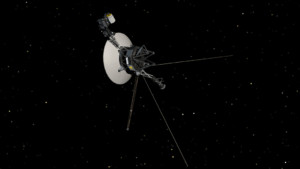[The following is Father Brendan’s homily for Holy Saturday.]
Do you remember where you were or what you were doing on St. Valentine’s Day, February 14 1990? I would be surprised if you did. I don’t. It may be a strange question to ask, but it’s related to an event that took place August 20, 1988.
That was the day NASA launched the Voyager 1 spacecraft. Its mission was to study Jupiter, Saturn and the moons of these two planets. Thirteen years later, Voyager was 4 billion miles from Earth and on the verge of leaving our solar system. It would be the first manmade object to go into interstellar space.
That was when the astronomer Carl Sagan, who had a part in planning the project, asked NASA to turn Voyager’s cameras around and snap a goodbye photo of planet earth way in the distance.
The photo became famous as “The pale blue dot”. Caught in the center of a single beam of light from the sun, Earth appears as a tiny blue orb in a vast, dark void. Just a speck in the immense cosmic ocean. Somewhere on that speck, the third rock from the sun, you and I were going about our daily lives. The photo of our planet turning around a medium sized star, in a nondescript neighborhood of the Milky Way galaxy, brings to mind the words of Psalm 8:
“what is man that you are mindful of him,
the son of man that you care for him?
You made him a little less than a god,
and crowned him with glory and honor”.
We seldom think of it, but there is a cosmic dimension to Easter. A dimension hinted at in the first reading from Genesis and again in the Easter Gospel. In the beginning was the first Creation. The resurrection of Christ was the beginning of the new creation.
First creation, new creation. Why did God create the world in the first place? Carl Sagan had no answer. He told us that every week, for 13 weeks from September to December on PBS. The program, “Cosmos” was the most widely watch tv series of its time winning two Emmy Awards.
I watched it faithfully back then. It provoked wonder and melancholy in equal amounts. Sagan explored the architecture of space and time, dark matter and dark energy, how galaxies form, why stars implode, how everything began, and how it’s all going to end.
But he also told us that the physical cosmos was all that existed: it was just the result of a series of chance occurrences. It has no meaning or purpose. We were all destined for extinction. In all its mystery and vastness, he said, there was no hint that help could come from elsewhere to save us.
Fortunately, there are other are other answers to the question “why creation?”. One of those is found in the writings of the early Church Father St. Irenaeus of Lyon.
Irenaeus reassures us that the Cosmos is not a meaningless, statistical accident. He taught that Christ is a savior by his very nature. The world and human beings in it were created to give him something to save. What’s the good of being a lifeguard if there’s a beach and water, but no swimmers.
What we celebrate in Easter is the revelation of a hidden plan for the salvation of the fallen human race. Irenaeus invented a term for this plan: he called it the “divine economy of salvation”.
This economy is first revealed in Genesis, progressively unveiled in the Law and the Prophets, and reaches full disclosure in the passion, death and resurrection of Jesus Christ. His return from the dead as a glorified human body tells us that God has directly entered his creation to rescue us from our fallen nature.
Easter is not merely a date on the calendar, it is the beginning of a new way of understanding of the world and how we should be living in it. Not as those who have no hope, no purpose or goal to their existence.
Voyager 1 is zipping along at 38,000 miles per hour in deep space 14 billion miles from earth. It has an appointment with Alpha Centuri, our nearest neighbor, 90,00 years from now.
When it took the photo of earth 20 years ago those without faith saw a pale blue dot in a meaningless void. The vastness of it all made human life look trivial. For those with eyes awake to the meaning of Easter, the world is charged with the glory of God.
On this night, the Divine Liturgy reminds us that baptism sacramentally inducted us into Christ’s saving death and resurrection. We now bear the full weight of Christ’s risen glory. And on the day of his return we will shine like the stars in the cosmos.

